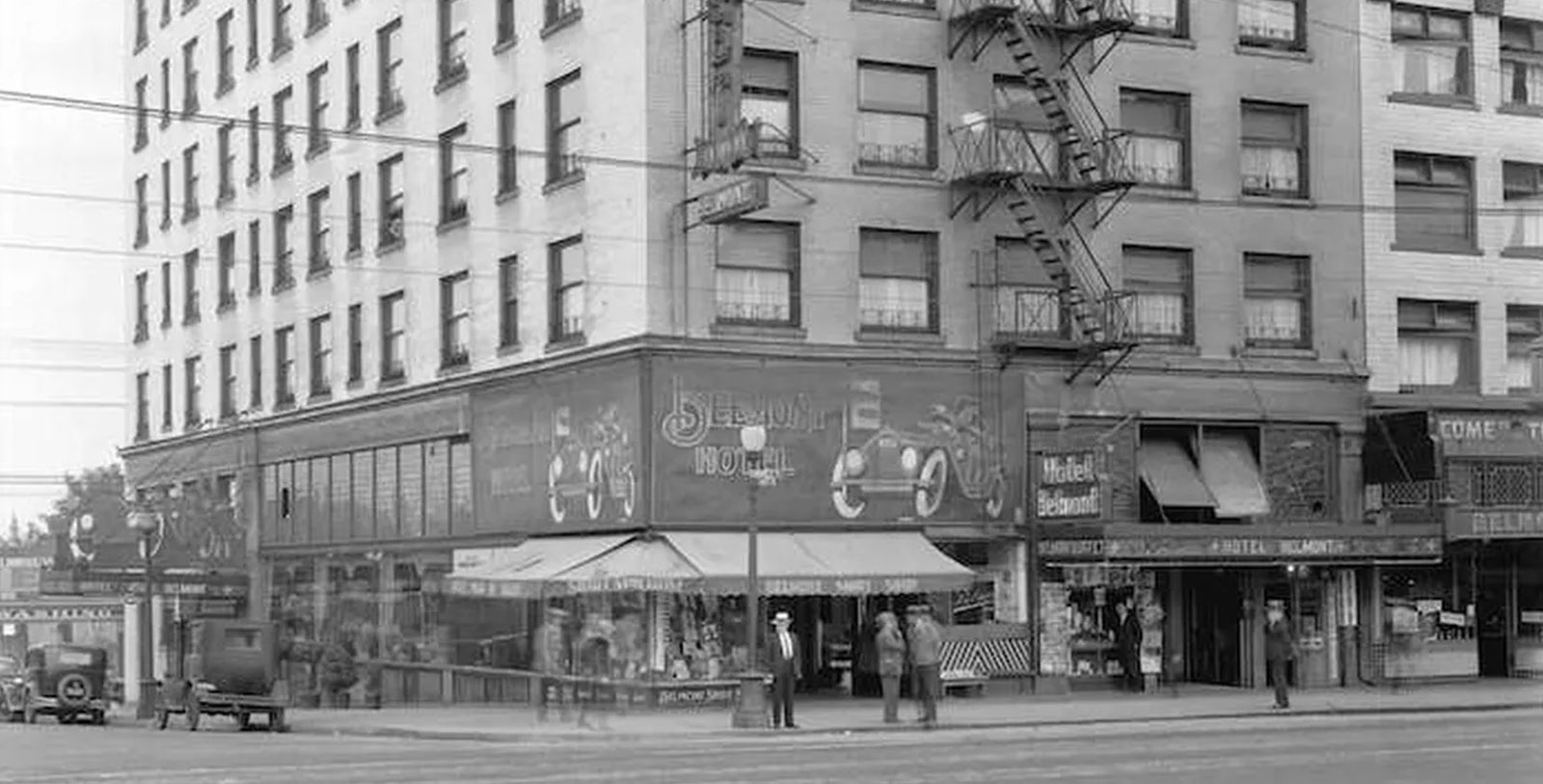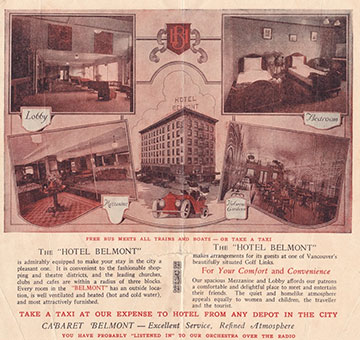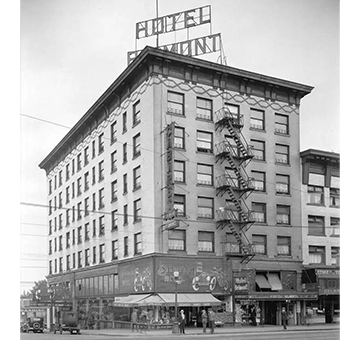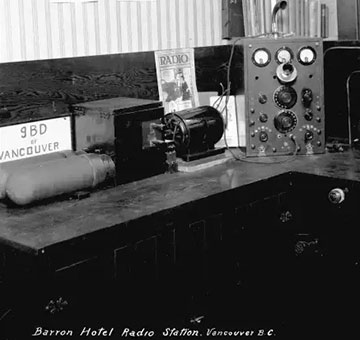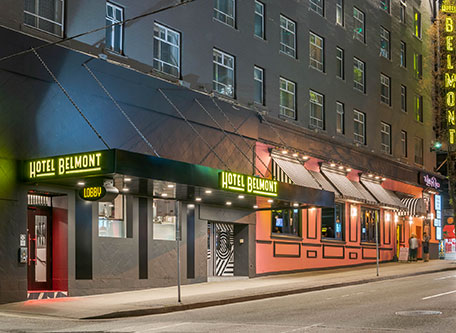Receive for Free - Discover & Explore eNewsletter monthly with advance notice of special offers, packages, and insider savings from 10% - 30% off Best Available Rates at selected hotels.
history
Discover the Belmont Hotel Vancouver MGallery, which was once a celebrated destination called the "Barron Hotel."
Belmont Hotel Vancouver MGallery, a member of Historic Hotels Worldwide since 2022, dates back to 1911.
VIEW TIMELINELocated in the heart of Vancouver’s Entertainment District, the Hotel Belmont Vancouver MGallery has been a cherished landmark for more than a century. In the early 1900s, it was built as an upscale hotel called the “Barron Hotel.” At the time, the surrounding neighborhood of Granville was experiencing a massive boom in commercial real estate development. The Canadian Pacific Railway had initially spurred the construction, as it wished to attract a wealth of new businesses near its Granville Street terminal. But the work was soon driven by the emergence of a robust local entertainment industry. Indeed, dozens of entrepreneurs had begun to open their own theaters, clubs, and restaurants throughout the district. Recognizing the economic potential, several hoteliers started to create hotels for the many tourists that were expected to flock into the area. Among the people to take advantage of the situation was Colonel Oscar Barron and his wife, Jennie Lane. Established hoteliers from New Hampshire, the Barrons subsequently partnered with a few family members—the Brophys—to launch the project. Together, they commissioned a Vancouver-based architectural firm called “Parr & Fee” to spearhead the design. Parr & Fee had long been active in Granville, having created many of the nearby buildings over the last several years. Like those earlier structures, the firm relied upon its unique adaptation of Edwardian-era architectural motifs to craft the hotel. Work began in 1911 and lasted a full year. The construction proved to be a massive undertaking, too, with the building permit alone costing more than $90,000!
The investment was a wise one, as the “Barron Hotel” received great acclaim when it opened in 1912. Featuring many outstanding guestrooms, the hotel provided a cozy haven in the heart of Vancouver. It also had many outstanding venues, such as the Barron Restaurant and Rose Room. (The dining establishment offered an eclectic menu of French-inspired cuisine that was supposedly based on the dishes served at the famous Parisian eatery, Le Baron.) There were a number of boutique storefronts that operated on the ground floor as well, which sold everything from textiles to cigars. Unfortunately, Colonel Barron did not get to watch the success of the business for long, as he died rather suddenly just months after the hotel debuted. Its daily operations fell to the Brophys, who continued to manage the business over the next couple of years. But during World War I, the two families decided to sell their shares. The Barron Hotel then passed among various owners until one of its general managers—W.D. Wood—bought it through an entity called the “Belmont Hotel Company” in 1925. Renaming the building as the “Belmont Hotel,” Wood’s management saw the business reach new heights of popularity. In fact, Wood organized an on-site band called the Belmont Orchestra, which performed nightly inside the hotel’s Rose Room. Wood even had his son, W.D. Wood Jr., broadcast the band’s shows through an amateur radio station that the he had set up in the upper floors of the hotel. The Belmont Orchestra became so popular that the prominent Canadian radio network CJOR started simulcasting its acts by the beginning of the 1930s.
Despite enduring such events like the Great Depression and World War II, the Belmont Hotel’s appeal began to weaken around the end of the 1950s. It remained open nonetheless, continuing to operate as the “Belmont Hotel” for some time thereafter. It eventually became known as the “Nelson Place Hotel” in the 1970s, and then as just the “Dakota Hotel.” But in 2017, Pacific Reach Properties acquired the site intent on completely restoring it back to its former glory. Construction began a year later, which thoroughly renovated every aspect of the building’s historic interior and exterior layout. Great efforts were undertaken to ensure that the revitalized hotel would cater to the preferences of contemporary travelers. For instance, the number of guestrooms were lowered in order to maximize comfort, and a series of fantastic facilities were installed that radiated a chic, retro ambiance. The new construction subsequently created an exhilarating atmosphere that wonderfully complemented the vibrancy of Granville Street’s famed nightlife. After months of continuous renovations, the building finally reopened as the “Belmont Hotel Vancouver MGallery” in 2021. Today, this revitalized historic hotel is one of Vancouver’s favorite holiday destinations. Its magnificent modern amenities and preserved historical architecture have enchanted countless guests since its rebirth. Cultural heritage travelers in particular have enjoyed the hotel’s character and its proximity to such renowned attractions like the Vancouver Art Gallery, The Orpheum, and the Queen Elizabeth Theatre.
-
About the Location +
One of Canada’s most preeminent cities, Vancouver’s history dates back well over a century ago. While several Native American tribes affiliated with the First Nations had inhabited the region for millennia, the first Euro-Americans did not arrive until onset of the Pacific Coast gold rush. Originating with the California Gold Rush, miners looking to strike it rich continuously traveled north along the coastline throughout the mid-19th century. By the 1860s, those aspiring entrepreneurs had reached British Columbia, establishing nascent settlements all around the Strait of Georgia. Additional settlers arrived over the next few decades, quickly replacing mining with lumber and milling as the primary industries in the region. Dozens of sawmills subsequently opened across the area, transforming the site of present-day Vancouver into one of the world’s leading producers of timber. Soon enough, railroad executives from across North America began developing railroads in the area in order to easily transport the wood to markets further south and along the East Coast. The Canadian Pacific Railway and the Canadian National Railway were the two most prominent railroad companies active in the region toward the end of the 1800s.
Eventually, the small milling villages between Burrard Inlet and Fraser River coalesced into a single community that the Canadian government formally charted as the “City of Vancouver” in 1886. While many Canadians formed the nucleus of this nascent city, Vancouver was home to a significant population of American expats. Several of the leading sawmills in the area were operated by Americans, as was a massive sugar refinery that is still in operation today. The city’s most frequently elected mayor was a man named L.D. Taylor, who had grown up in the United States. In fact, the decision to name the city “Vancouver” had been the idea of American resident William Van Horne. Horne was an incredibly important person in Canada at the time, for he served as the President of the Canadian Pacific Railway. (The name itself was derived from an English explorer named George Vancouver, who navigated the local shoreline back in 1792.) More of the surrounding towns joined Vancouver during the early 20th century, which further enhanced its importance as a center of commerce. By the time World War II concluded, Vancouver had grown to become Canada’s third largest city, as well as its most prominent port on the Pacific Ocean—two distinctions that it still proudly bears today.
-
About the Architecture +
When the architectural firm Parr & Fee constructed the Hotel Belmont Vancouver MGallery, it relied upon architectural motifs that were then popular during Canada’s Edwardian period. When King Edward VII assumed the throne upon the death of his mother, Queen Victoria, it marked the beginning of a momentous—albeit brief—period of dynamic cultural expression for English society. Historians today refer to his reign as the “Edwardian Era,” which lasted from 1901 right up to the outbreak of World War I. Among the advances in art that defined the age was the wholesale embrace of new architectural forms. Architects and engineers throughout the United Kingdom were eager to utilize different design philosophies of the artistic tastes that characterized the previous century. Looking back to the Enlightenment, those building professionals started borrowing the structural aesthetics of Neoclassicism and Georgian architecture once again, infusing it with their preexisting concepts of Victorian architecture. As such, most buildings constructed throughout the Edwardian Era featured recognizable structural elements like frames of half-timbered exteriors that were typically filled with some form of brick or plaster. Sometimes, architects would fill the frame with a mixture known as “pebbledash,” which consisted of lime, sand and stone. The layout of the wood was so pronounced in a few cases that it made the structures resemble something developed at the time of the Tudors. Paneled doors outfitted with ornate stained glass were also commonplace, as was the presence of painstakingly carved wooden porches. Popular in the 18th century, the multipaned sash window became widespread once more, which allowed natural light to flood a building’s many open spaces. Bay windows—another holdover from the Georgian Era—would have been used frequently, too.



















